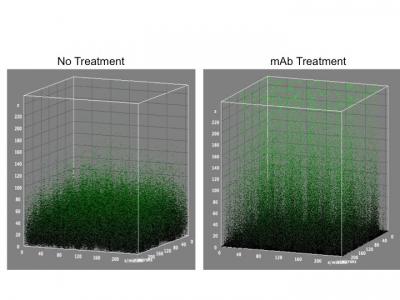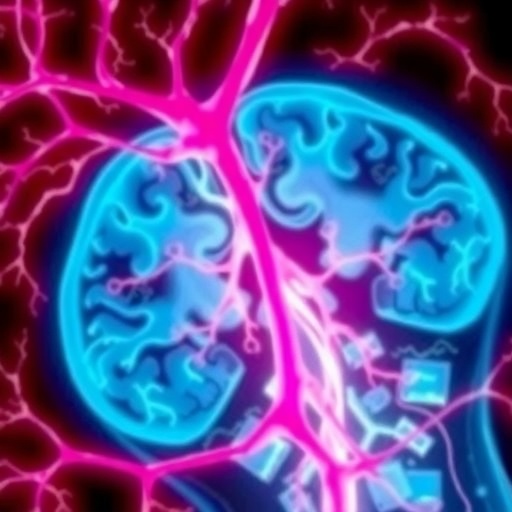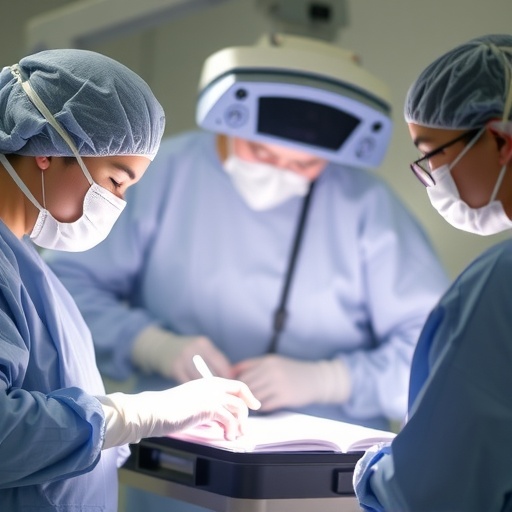Communities of bacteria known as biofilms are notorious for forming on implanted medical devices and tissues in the body, where they give rise to chronic, sometimes life-threatening infections

Credit: Lewis Katz School of Medicine at Temple University
(Philadelphia, PA) – The same way baking soda breaks down grease and grime, making surfaces easier to clean, researchers at the Lewis Katz School of Medicine at Temple University (LKSOM) now show that a new therapeutic molecule can break apart communities of harmful bacteria, opening the way for bacteria-killing antibiotics to more effectively clear out infections.
Communities of bacteria known as biofilms are notorious for forming on implanted medical devices, such as catheters and prosthetics, and on tissues in the body, where they give rise to chronic and sometimes life-threatening infections in patients. Biofilms are extremely difficult to eradicate, because, united with an impermeable matrix, the microbes are able to resist antibiotics and other agents that would otherwise eliminate them.
The new molecule, a type of monoclonal antibody, however, is able to open up these biofilms, causing their dissociation. It is the first agent of its kind to show promise as an immunotherapeutic strategy to fight off infectious biofilms.
“With this new antibody, we open the door for better treatment strategies for patients who suffer from chronic infections associated with implanted medical devices or who suffer from recurrent infections, such as repeated infections of the urinary tract,” explained Cagla Tukel, PhD, Associate Professor in the Department of Microbiology and Immunology at LKSOM, and senior author on the new study.
The study was published online in the journal Nature Communications.
The new antibody, named 3H3, was isolated from a healthy human subject by Scott K. Dessain, MD, PhD, a professor at the Lankenau Institute for Medical Research and coauthor on the new study. Drs. Dessain and Tukel were intrigued by 3H3’s ability to attach to beta-amyloid, a sticky protein that functions abnormally in Alzheimer’s disease. A form of amyloid called curli is secreted by bacterial cells and is a major component of biofilms. Bacterial amyloid curli acts like glue, enabling bacterial cells to adhere to one another and form a continuous film over a surface.
In experiments with biofilms of infectious Salmonella enterica serovar Typhimurium, which forms biofilms in the human intestinal tract and on medical devices, Dr. Tukel’s team found that amyloid binding by 3H3 disrupted biofilm formation, causing the separation of bacterial cells within the biofilm. The researchers then tested the antibody in mice infected with catheter-associated S. Typhimurium biofilm. In these animals, 3H3 injections also led to biofilm dissociation and, when followed by antibiotic therapy, allowed for the swift eradication of individual bacterial cells from the animals.
There are currently no existing therapies that are used clinically to break up biofilms. Here Dr. Tukel’s team showed that while 3H3 breaks the biofilm, it also prevented the dissociating bacteria from entering the circulation, where they could cause sepsis. 3H3 was found to bind to individual bacterial cells facilitating their uptake by immune cells. Therefore, this novel approach has the potential to reduce the risk of sepsis.
“We are very excited about these findings,” Dr. Tukel said. “There is great need for an immunotherapy that can be used alongside lower dose antibiotics or other antimicrobials to safely and effectively eradicate biofilms in infectious settings.”
Dr. Tukel and colleagues plan next to test 3H3 on a wide variety of biofilms. As many important pathogenic bacteria produce curli or curli-like amyloids in their biofilms, such as Escherichia coli, Staphylococcus aureus and Pseudomonas aeruginosa, this novel immunotherapy has the potential to be applied to a wide variety of infections.
“We also are developing a clinical approach,” Dr. Tukel noted. “Our preclinical findings in animals are promising, and we’ve identified a clear path to clinical development.”
###
Other researchers who contributed to the new work include: Sarah A. Tursi, Lauren K. Nicastro, Amanda L. Miller, Connie Qiu, Stefania Gallucci, and Bettina A. Buttaro, Department of Microbiology and Immunology, LKSOM; Rama Devudu Puligedda, Lankenau Institute for Medical Research, Wynnewood, PA; and Paul Szabo and Norman R. Relkin, Weill Cornell Medical Feil Family Brain & Mind Research Institute, New York.
The research was supported in part by funding from the National Institutes of Health, National Institute of Allergy and Infectious Diseases and from the Lankenau Institute for Medical Research.
About Temple Health
Temple University Health System (TUHS) is a $2.2 billion academic health system dedicated to providing access to quality patient care and supporting excellence in medical education and research. The Health System consists of Temple University Hospital (TUH); TUH-Episcopal Campus; TUH-Jeanes Campus; TUH-Northeastern Campus; The Hospital of Fox Chase Cancer Center and Affiliates, an NCI-designated comprehensive cancer center; Temple Transport Team, a ground and air-ambulance company; Temple Physicians, Inc., a network of community-based specialty and primary-care physician practices; and Temple Faculty Practice Plan, Inc., TUHS’s physician practice plan comprised of more than 500 full-time and part-time academic physicians in 20 clinical departments. TUHS is affiliated with the Lewis Katz School of Medicine at Temple University.
Temple Health refers to the health, education and research activities carried out by the affiliates of Temple University Health System (TUHS) and by the Katz School of Medicine. TUHS neither provides nor controls the provision of health care. All health care is provided by its member organizations or independent health care providers affiliated with TUHS member organizations. Each TUHS member organization is owned and operated pursuant to its governing documents.
It is the policy of Temple University Health System that there shall be no exclusion from, or participation in, and no one denied the benefits of, the delivery of quality medical care on the basis of race, ethnicity, religion, sexual orientation, gender, gender identity/expression, disability, age, ancestry, color, national origin, physical ability, level of education, or source of payment.
Media Contact
Jeremy Walter
[email protected]
267-838-0398
Original Source
https:/
Related Journal Article
http://dx.




